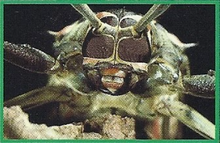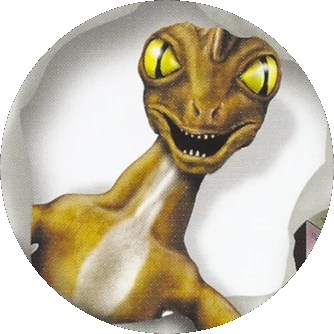Looks can be deceiving when it comes to this insect. The harlequin beetle has long legs tipped with vicious-looking, spiked claws, but the insect never uses them as weapons. Plus, this beetle's back is covered with bright colors-usually a sign that a creature is poisonous-but it doesn't contain a single toxin. The beetle uses these bluffs to deter predators so it can swing among small tree branches in peace and drink sweet tree sap.
Fake Out: If threatened, this beetle holds out its long front legs in an attack pose, but it's all for show. The spiked feet and the wild color patterns on the insect's body fool attackers into thinking the creature has deadly claws and that it might be poisonous.
All Aboard: This beetle carries some baggage. Tiny red mites attach themselves to the beetle to suck nutrients from its body, and tiny false scorpions climb aboard to eat up the mites.
A Real Swinger[]

This beetle's jaws are made for gnawing through bark and sucking up sap.
The harlequin beetle is a clumsy insect when it walks and flies. On the ground, the beetle's long front legs get in its way if it tries to move quickly, so the creature usually pulls itself along with these awkward legs. In the air, this bulky beetle easily loses control (again because of its long front legs), and ends up clunking against trees and falling to the ground. The harlequin beetle's awkward legs are best used as "arms." When up in a tree, the insect grabs onto branches and swings like it's on a jungle gym as it searches for sweet deposits of sap to eat.
Woodchipper: Females lay their eggs in the trunks of trees. The larvae burrow deeper into the tree when they hatch, and munch up the wood with their strong jaws. The young insects transform into adults while still inside the tree.
Noisemaker: The harlequin beetle is a noisy insect. In flight, its wings beat heavily, sounding like a miniature helicopter. On the ground, the armor of the beetle's legs creak with very step.
Dead Tree Society[]
Several harlequin beetle larvae may hatch in the same tree around the same time. As several of the young insects burrow through the trunk, they cut through the "veins" that bring nutrients to the leaves and branches, and the trees usually die. However, female harlequins are often attracted to sick trees, so their young end up helping to stop the spread of disease and actually make their home forests healthier.
Trading Card[]
Trivia[]
- The bottom segment on the back of the knowledge card, "Dead Tree Society", is a reference to the 1989 film, Dead Poets Society.

